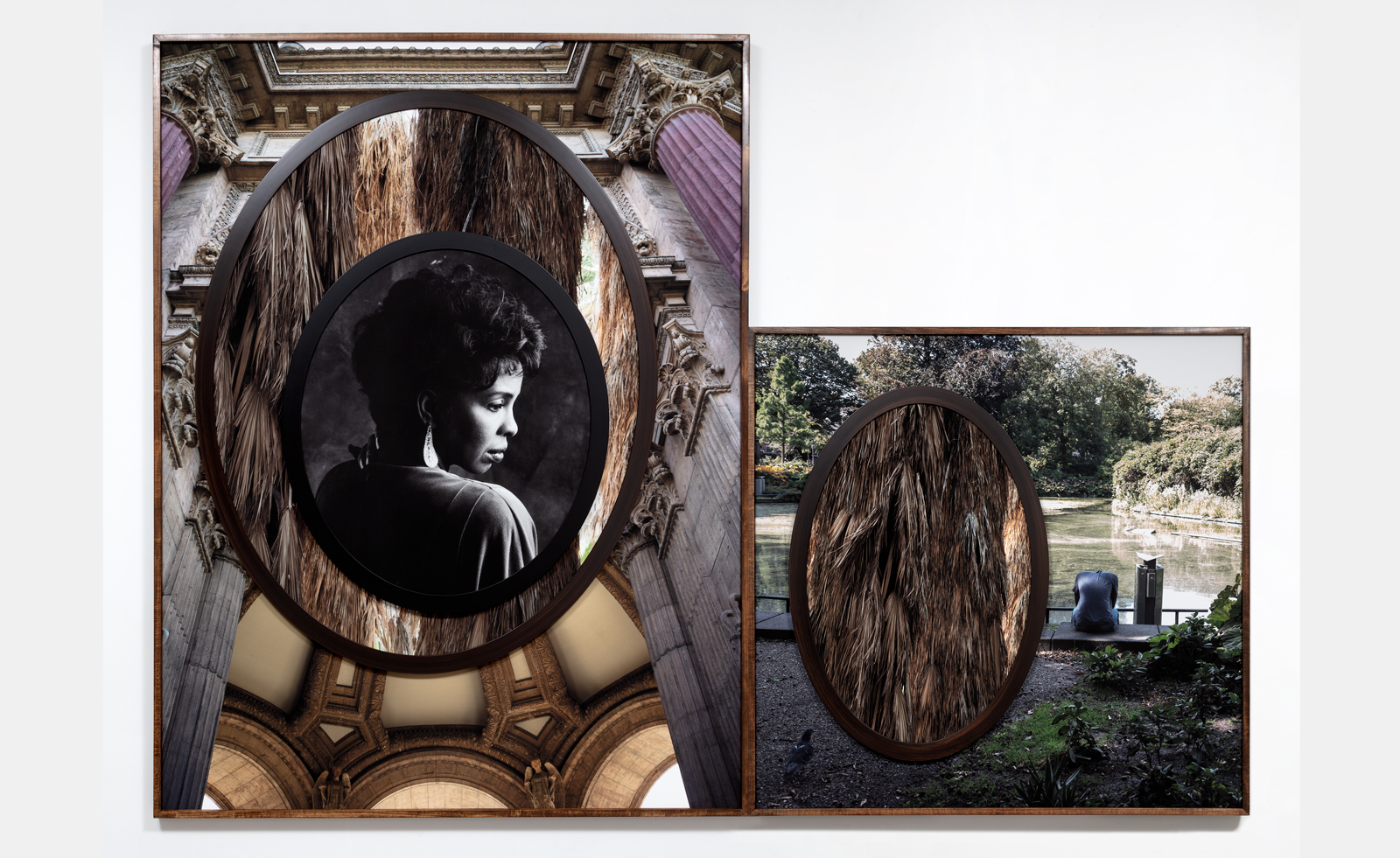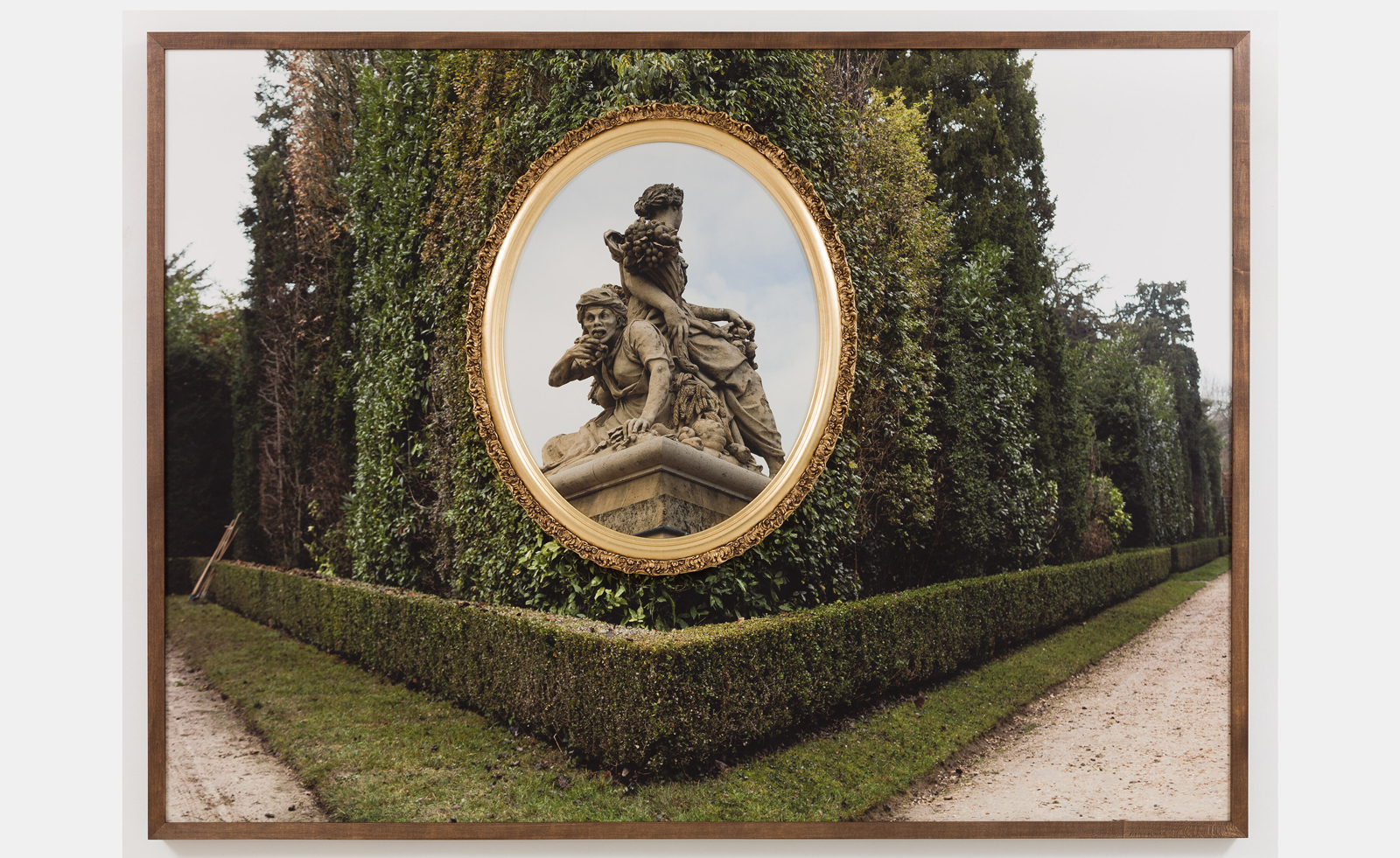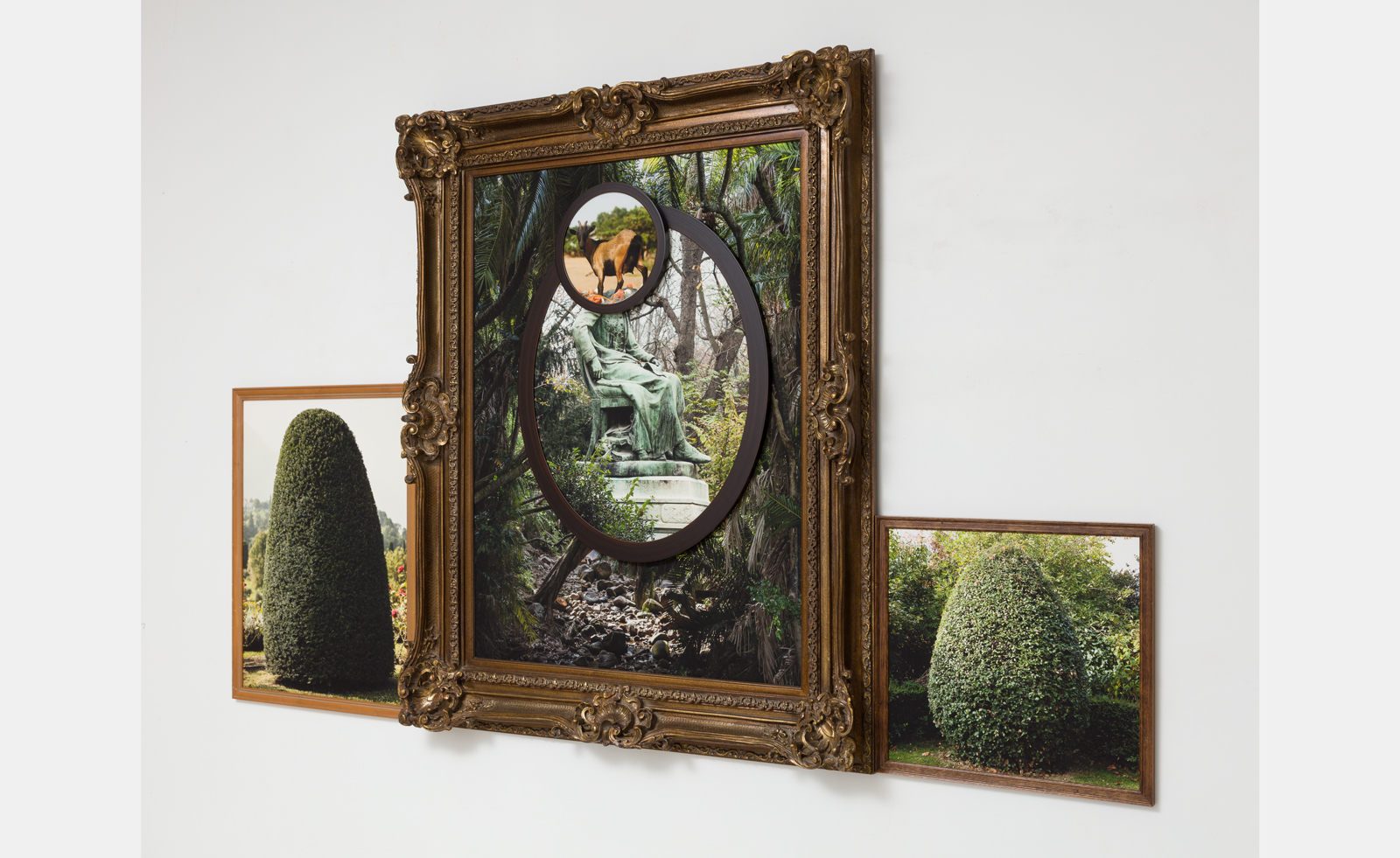Todd Gray’s sculptural photography collages defy dimension, linearity and narrative
In Todd Gray’s New York exhibition, he revisits his 40-year archive, fragmented into elaborated frames that open doors for new readings

Todd Gray assembles his photographs so as to draw attention to what remains outside the frame, as much as on the content inside. The artist’s intricately constructed collages of pictures that he takes in various parts of the world – from the wetlands of Ghana to the Palais de Versailles – are akin to poetic verses. Like a carefully chosen word, each image joins a constellation of a few, and together, they reveal uncharted meanings beyond the seen. Through framing cut-out portions from his own archive, the artist frees the image from a singular narrative.
It’s a case of ‘rupturing the seamlessness of photographic imagery’, as Gray explains his gesture to Wallpaper*. A shot of an African woman in traditional garb, for example, is orchestrated with that of a palatial door; or, two ornately trimmed trees bookend a pile of three frames that show a lush forest, a stone monument, and a wild animal. Some ornate and others minimal, the frames both underline and confine Gray’s allusive images, while pointing at the potential in the unseen.
‘Reality Reframed: Recent Works by Todd Gray’

Todd Gray, Cosmic Trail of Tears (above/below), 2022. Four archival pigment prints with UV laminate and artist's frames
Gray’s new exhibition, ‘Reality Reframed: Recent Works by Todd Gray’, at The 8th Floor in New York, includes images he snapped in the last 40 years from his travels and life between America’s west coast and Akwidaa in Ghana. In contrast to the pictures’ ample timeframe, the resulting three-dimensional works are from the last five years, letting the artist take a retrospective look at his own holdings.
Delving into his repertoire through collage helps Gray revisit the moment of pressing the shutter, bridging the emotionality of the past act with the very moment. Although he operates from the ‘theoretical foundation of questioning power, hegemony, and colonialism’, he admits, ‘I am not thinking about them while I am shooting.’
The immediate bodily instinct to monumentalise a still is a drive Gray began appreciating in the late 1990s after graduating from CalArts, where he studied under John Baldessari and Allan Sekula. ‘I began questioning why I was relying on rational thought and [pre-visualising] a picture,’ he remembers. The epiphany imbued the artist with a desire to operate ‘like a jazz musician who improvises and let my body come into the process’. Along the way, he found himself resisting the binary readings in photography and shift to what he calls ‘the polymorphous’.

Todd Gray, Nike D.O. / Versailles, 2021. Three archival pigment prints in artist's frames, UV laminate
The multitude of contexts in his strategically collaged and intricately built sculptural photographs open doors for subjective readings on power structures and the biased linearity of history. ‘Multiple temporalities in a singular visual field’, as Gray describes his non-hierarchal stacking of places and people. ‘I am creating a rupture between the ancient time, recent time, and contemporary time, with multiple chronologies to connect to.’
In Euclidean Gris Gris (Ship of Fools) (2019), a bronze statut shows a European woman holding a cornucopia and an enslaved African woman underneath eating the fruit bits falling from the bunch. Gray juxtaposes the circular image of the troubling monument in Versailles with a horizontal landscape from the same garden. The ornate frame holding the two women overlaps and slices the precisely sculpted bushes.
Receive our daily digest of inspiration, escapism and design stories from around the world direct to your inbox.

Todd Gray, the hidden order of the whole, 2021. Five archival pigment prints in artist's frames, UV laminate
The artist’s interest in capturing architecture lies in the comparison he finds between pictures and edifices. ‘Architecture freezes time, like an image,’ he says. A quartet of semblances inhabits Atlantic (Keisha's Redemption Song) (2022). The largest frame is a vertical image of the Official Palace of Portugal with saints perched over its arch. Gray overlaps the flamboyant architecture with another vertical – yet smaller – shot of the Grand Rotunda at the Palace of Fine Arts in San Francisco, where elaborate columns convey a similar old worldly grandiosity.
A contemplative shot of the Atlantic Ocean from Gray’s own Ghana home in an oval frame is finally crowned with a portrait of the American singer Keisha Jackson, whose face is concealed with a shot of the space taken from Hubble telescope. The infinity that substitutes for the woman’s likeness pairs with the aquatic endlessness that once carried enslaved Africans towards Europe and America where they were forced to build still-enduring architectural legacies.

Todd Gray, Euclidean Gris Gris (Ship of Fools), 2019. Two archival pigment prints in artist's frames and found frames, UV laminate
Travelling with Michael Jackson as his personal photographer between his Off The Wall and Thriller eras in the 1980s ushered an understanding of the images’ account for representation. In his pictures of the world’s most famous pop star during his career peak, Gray saw ‘mental colonialism’, and how Black representation is fragmented and repurposed through collective consciousness and media. Reading Toni Morrison and Stuart Hall ‘switched something in my brain around 2013’, Gray says about the moment he began covering Jackson’s face in his fine art photography. ‘Michael was the poster child of mental colonialism of the African diaspora,’ he adds.
David Lewis gallery’s Frieze LA 2024 booth included a work from Gray’s On Pointe series, which features fragmented images of Jackson with immediate recognisability. On Pointe (Atlantic) (2024) builds a transcontinental and pan-historical composition of places and people: a circular frame holds a photograph of a Ghanaian chief during the harvest festival in Axi, laid over another circular shot of Jackson’s iconic toe point stage move that sits on a large shot of the Atlantic Ocean from Ghana. The corporal thread between two performing Black bodies – one in a communal ritual and the other in an arena in front of thousands – is tied through the eerie infinity of the ocean with an unknown destination waiting on the horizon.
‘Reality Reframed: Recent Works by Todd Gray’ is on view at The 8th Floor, New York, through 13 April 2024.

Euclidean Gris Gris (Scales of Injustice, No Respect), 2019. Five archival pigment prints in artist's frames and found frames, UV laminate
Osman Can Yerebakan is a New York-based art and culture writer. Besides Wallpaper*, his writing has appeared in the Financial Times, GQ UK, The Guardian, Artforum, BOMB, Airmail and numerous other publications. He is in the curatorial committee of the upcoming edition of Future Fair. He was the art and style editor of Forbes 30 Under 30, 2024.
-
 Art and culture editor Hannah Silver's top ten interviews of 2025
Art and culture editor Hannah Silver's top ten interviews of 2025Glitching, coding and painting: 2025 has been a bumper year for art and culture. Here, Art and culture editor Hannah Silver selects her favourite moments
-
 In Norway, remoteness becomes the new luxury
In Norway, remoteness becomes the new luxuryAcross islands and fjords, a new wave of design-led hideaways is elevating remoteness into a refined, elemental form of luxury
-
 The rising style stars of 2026: Oscar Ouyang is taking knitwear into new realms
The rising style stars of 2026: Oscar Ouyang is taking knitwear into new realmsAs part of the January 2026 Next Generation issue of Wallpaper*, we meet fashion’s next generation. Born in Beijing, Central Saint Martins graduate Oscar Ouyang is inspired by anime, medieval folklore and his friends’ wardrobes
-
 Out of office: The Wallpaper* editors’ picks of the week
Out of office: The Wallpaper* editors’ picks of the week'Tis the season for eating and drinking, and the Wallpaper* team embraced it wholeheartedly this week. Elsewhere: the best spot in Milan for clothing repairs and outdoor swimming in December
-
 Nadia Lee Cohen distils a distant American memory into an unflinching new photo book
Nadia Lee Cohen distils a distant American memory into an unflinching new photo book‘Holy Ohio’ documents the British photographer and filmmaker’s personal journey as she reconnects with distant family and her earliest American memories
-
 Out of office: The Wallpaper* editors’ picks of the week
Out of office: The Wallpaper* editors’ picks of the weekIt’s been a week of escapism: daydreams of Ghana sparked by lively local projects, glimpses of Tokyo on nostalgic film rolls, and a charming foray into the heart of Christmas as the festive season kicks off in earnest
-
 Ed Ruscha’s foray into chocolate is sweet, smart and very American
Ed Ruscha’s foray into chocolate is sweet, smart and very AmericanArt and chocolate combine deliciously in ‘Made in California’, a project from the artist with andSons Chocolatiers
-
 Inside the work of photographer Seydou Keïta, who captured portraits across West Africa
Inside the work of photographer Seydou Keïta, who captured portraits across West Africa‘Seydou Keïta: A Tactile Lens’, an exhibition at the Brooklyn Museum, New York, celebrates the 20th-century photographer
-
 Out of office: The Wallpaper* editors’ picks of the week
Out of office: The Wallpaper* editors’ picks of the weekFrom sumo wrestling to Singaporean fare, medieval manuscripts to magnetic exhibitions, the Wallpaper* team have traversed the length and breadth of culture in the capital this week
-
 María Berrío creates fantastical worlds from Japanese-paper collages in New York
María Berrío creates fantastical worlds from Japanese-paper collages in New YorkNew York-based Colombian artist María Berrío explores a love of folklore and myth in delicate and colourful works on paper
-
 Out of office: the Wallpaper* editors’ picks of the week
Out of office: the Wallpaper* editors’ picks of the weekAs we approach Frieze, our editors have been trawling the capital's galleries. Elsewhere: a 'Wineglass' marathon, a must-see film, and a visit to a science museum